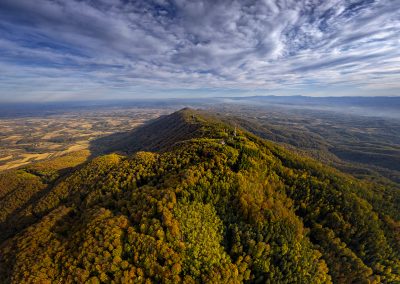Forest Watchtower
In the very heart of Mount Cer, on the southwestern slope below its highest peak Šančine, lie the remnants of Kosanin Grad (Kosana’s Town), a Roman fortification built in the late 3rd or early 4th century AD, most likely during the reign of Emperor Constantius I Chlorus. It was, in fact, a military watchtower and observation post, which, along with the nearby Roman fort of Trojanov Grad (Trojan’s Town), served to protect the mines and mining settlements of Cer from plunder and barbarian raids, as well as the road that passed through the area.
ABOVE: Map of the site

ABOVE: The watchtower stood on a small rocky elevation, now overgrown with forest
The small, rectangular tower lies on the left side of a steep ravine formed by the Kostola mountain stream, whose source is located slightly above the fortification. Interestingly, the area around Kosanin Grad is called the Kostol peak, a toponym derived from the Latin word castel—meaning castrum, or fortification. Only the remains of the foundation of the former watchtower are visible on the truncated cone-shaped hill, along with faint traces of surrounding trenches. The tower once had visual communication with Trojanov Grad, though today it is overgrown by forest. A Roman road once passed near the site, connecting the Jadar Valley, over the ridge of Mount Cer, to Pocerina, linking Kosanin Grad with Trojanov Grad on the easternmost side and Vidin Grad (Vida’s Town) on the westernmost side of the mountain. During the Roman Empire, the Cer ridge marked the boundary between the provinces of Lower Pannonia to the north and Dalmatia to the south, giving this position considerable strategic importance.


Above: LEFT: The base of the tower is rectangular in shape. RIGHT: Detail of the wall
Although the mention of the fortress has been preserved among the locals through the toponym itself, visible traces at the site were minimal until archaeological research in 1982. Consequently, researchers who visited the site in the mid-20th century could only discern a small amount of scattered broken stone (Đorđe Bošković, Archaeological Monuments and Sites in Serbia, I: Western Serbia, Belgrade, 1953). Archaeologist Milivoj Vasiljević from the Šabac Museum carried out the excavation. Kosanin Grad is listed as an archaeological site under preliminary protection, which means it has been treated as a protected cultural monument since 1978.

ABOVE: The ridge of Mount Cer, where a road passed during Roman times, as well as the boundary between two provinces
It is important to note that in the literature, particularly that related to the Battle of Cer in World War I, the location at the summit of the mountain, where the fiercest battles between the Serbian and Austro-Hungarian armies were fought, is mistakenly identified as “Kosanin Grad.” This error originates from outdated geographical maps; however, the correct designation for this location is now “Šančina,” named after the trenches dug there during the battle.
List of References
- Archaeological Institute of the Serbian Academy of Sciences and Arts (SASA). Archaeological Monuments and Sites in Serbia – I: Western Serbia. Materials, Vol. IX. Vol. 2. Belgrade: SASA, 1953.
- Grčić, M., and Grčić. Lj. “The First Inhabited Cities of Christianized Serbia in the 10th Century According to Constantine Porphyrogenitus, on the Map of Guillaume Delisle.” Bulletin of the Serbian Geographical Society 92, no. 2 (2012): 1–22.

ABOVE: Aerial view of the site
The Legend of the Town’s Name
On Mount Cer, an old Slavic legend unfolds about the mythical Emperor Trojan, a forest demon with three heads and goat-like ears, and his five daughters. According to the tale, long ago, Emperor Trojan fell in love with a woodland fairy of Mount Cer, whose power was within her hair and cloak. Desiring her, Trojan deceitfully took her cloak and forced her to stay by his side. In time, she bore him five daughters, but, in vengeance for his deceit, she cursed him never to find his fifth daughter or learn her name.
Trojan built five towns, naming them after each of his daughters. Thus, Soka’s town was called Soko Grad in the Sokolske Mountains, Koviljka’s became the town of Banja Koviljača, Vida’s was Vidin Grad on the peak of Vidojevica, and Kosana’s town was named Kosanin Grad on Mount Cer. The fate of the fifth daughter and her city remains a mystery.
In another, lesser-known version of the tale, the origin of Kosanin Grad is related to Kosana, the sister of the renowned hero Miloš Obilić.

ABOVE: The forest above Kosanin Grad
Prehistoric Mining
Cer Mountain boasts the most abundant tin ore deposits in Serbia and beyond. Recent archaeological explorations have shown that this rare metal—rarer than gold, silver, or copper—was mined on Cer as far back as prehistoric times. Notably, the wealthiest Bronze Age tombs are in the area surrounding the mountain. Although the tin deposits lie deeply under the surface, at around 700 meters, rivers bring Cassiterite ore to the surface in the spring when the snow melts. This natural process allowed tin to be extracted here during the Bronze Age.
Explore nearby fortresses
Šabac Fortress
Trojanov Grad










